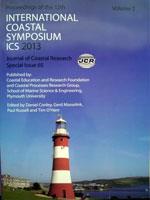Gomes, V.J.C., Freitas, P.T.A., Asp, N.E., 2013. Dynamics and seasonality of the middle sector of a macrotidal estuary
This study presents the results on the hydrodynamic evaluation of the middle sector of the Caeté estuary (North Brazil), considering seasonal variations of rainfall and fluvial discharge, as well as neap-spring tidal cycle. Measuring campaigns were performed over 13 hours at spring and neap tides during 2011. There, cross-sectionally averaged current velocities and direction, water levels, salinity and SSC (suspended solid concentration) were monitored. The evaluated estuarine sector showed an asymmetric tidal pattern as expected, with higher current velocities during the ebb, although this tidal phase was persistently longer. The flood phase presented two discernible velocity peaks, especially during the spring tide, where the main peak occurs at the first half of the flood, as it flows landwards into the channel, and a secondary peak, as the large contiguous mangrove areas are flooded. Ebb currents were generally higher (e.g. 1.3 m.s−1 at spring/wet season) than during the flood (e.g. 1.1 m.s−1 at spring/wet season). The flood tidal currents surpass the ebb currents only during neap cycles at the dry season (0.74 m.s−1 at ebb and 0.78 m.s−1 at flood phase). The SSC could be directly related to the current velocities, therefore with the resuspension process. Nevertheless, SSC, as well as current velocities, were substantially higher at the spring tides, when the suspended sediment is effectively transported. During spring tides at the wet season SSC reached more than 3 g.L−1. Salinity variation within a tidal cycle was much higher during the spring tide (e.g. 22 at dry and 2 at wet season) than during the neap (e.g. 14 at dry and 0 at wet season), as well as at the dry season, in comparison with the dry season. This process would be the result of the seasonal longitudinal displacement of the mixing zone due to strong fluvial discharge variation. At the same time the mixing zone is also displaced according to the spring/neap variation. The same process would explain SSC variations, due to turbidity maximum zone migration in association with salinity, as SSC measurements suggest. Therefore, the presented results have showed the substantial relevancy of flood/ebb, spring/neap and wet/dry season variations for hydrology at this estuarine sector.





